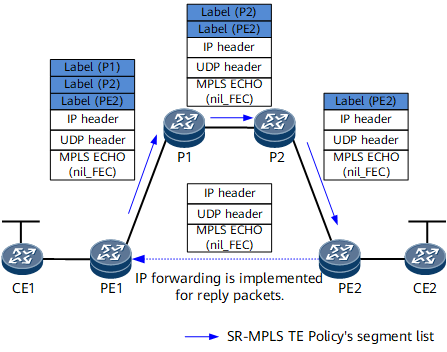SR-MPLS TE Policy OAM
SR-MPLS TE Policy operations, administration and maintenance (OAM) is used to monitor SR-MPLS TE Policy connectivity and quickly detect SR-MPLS TE Policy faults. Currently, SR-MPLS TE Policy OAM is implemented through ping and tracert tests.
- SR-MPLS TE Policy-level detection: You can configure multiple candidate paths for an SR-MPLS TE Policy. The valid path with the highest preference is the primary path, and the valid path with the second highest preference is the backup path. Multiple segment lists of a candidate path work in load balancing mode. The same candidate path can be configured for different SR Policies. SR-MPLS TE Policy-level detection is to detect the primary and backup paths in an SR-MPLS TE Policy.
- Candidate path-level detection: This detection is basic and does not involve upper-layer policy services. It only detects whether a candidate path is normal.
Policy-level detection is equivalent to candidate path-level detection if the preferred primary and backup paths are found. If the primary and backup paths have multiple segment lists, the ping and tracert tests check all the segment lists through the same process and generate test results.
SR-MPLS TE Policy Ping
On the network shown in Figure 1, SR is enabled on the PE and P devices on the public network. An SR-MPLS TE Policy is established from PE1 to PE2. The SR-MPLS TE Policy has only one primary path, and its segment list is PE1->P1->P2->PE2.
The process of initiating a ping test on the SR-MPLS TE Policy from PE1 is as follows:
PE1 constructs an MPLS Echo Request packet. In the IP header of the packet, the destination IP address is 127.0.0.0/8, and the source IP address is the MPLS LSR ID of PE1. MPLS labels are encapsulated as a SID label stack in segment list form.
Note that, if an adjacency SID is configured, headend device PE1 only detects the FEC of P1. As a result, after the ping packet reaches PE2, the FEC of PE2 fails to be verified. Therefore, to ensure that the FEC verification on the endpoint device succeeds in this scenario, the MPLS Echo Request packet must be encapsulated with nil_FEC.
PE1 forwards the packet to P1 and P2 hop by hop based on the segment list label stack of the SR-MPLS TE Policy.
P2 removes the outer label from the received packet and forwards the packet to PE2. In this case, all labels of the packet are removed.
PE2 sends the packet to the host transceiver for processing, constructs an MPLS Echo Reply packet, and sends the packet to PE1. The destination address of the packet is the MPLS LSR ID of PE1. Because no SR-MPLS TE Policy is bound to the destination address of the reply packet, IP forwarding is implemented for the packet.
After receiving the reply packet, PE1 generates ping test results.
If there are primary and backup paths with multiple segment lists, the ping test checks all the segment lists.
SR-MPLS TE Policy Tracert
On the network in Figure 1, the process of initiating a tracert test on the SR-MPLS TE Policy from PE1 is as follows:
PE1 constructs an MPLS Echo Request packet. In the IP header of the packet, the destination IP address is 127.0.0.0/8, and the source IP address is an MPLS LSR ID. MPLS labels are encapsulated as a SID label stack in segment list form.
PE1 forwards the packet to P1. After receiving the packet, P1 determines whether the outer TTL minus one is zero.
If the outer TTL minus one is zero, an MPLS TTL timeout occurs and P1 sends the packet to the host transceiver for processing.
If the outer TTL minus one is greater than zero, P1 removes the outer MPLS label, buffers the value (outer TTL minus one), copies and pastes the value to the new outer MPLS label, searches the forwarding table for the outbound interface, and forwards the packet to P2.
Similar to P1, P2 also determines whether the outer TTL minus one is zero.
If the outer TTL minus one is zero, an MPLS TTL timeout occurs and P2 sends the packet to the host transceiver for processing.
If the outer TTL minus one is greater than zero, P2 removes the outer MPLS label, buffers the value (outer TTL minus one), copies and pastes the value to the new outer MPLS label, searches the forwarding table for the outbound interface, and forwards the packet to PE2.
After receiving the packet, PE2 removes the outer MPLS label and sends the packet to the host transceiver for processing. In addition, PE2 returns an MPLS Echo Reply packet to PE1, with the destination address of the packet being the MPLS LSR ID of PE1. Because no SR-MPLS TE Policy is bound to the destination address of the reply packet, IP forwarding is implemented for the packet.
After receiving the reply packet, PE1 generates tracert test results.
If there are primary and backup paths with multiple segment lists, the tracert test checks all the segment lists.
